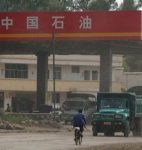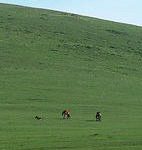Years before China completed its first certified green building, a team from Beijing went to meet with engineers in the US to discuss environmentally-friendly design. But when the Chinese team showed some early sketches to their American colleagues, the response was not what they were expecting.
The American engineers said the plans were completely unworkable – the lighting design, water systems, ventilation and so on would all to be redone. This setback left Gao Lin, the lead Chinese architect on the project, “looking completely shell shocked,” recalls Robert Watson, a senior scientist with the New York-based Natural Resources Defense Council, who advises the Chinese government on green construction. “He blinked and looked at me and said, ‘It’s like I’m seeing architecture for the first time.’”
Though it may lack the flair of much of Beijing’s newer designs, the resulting building, completed in 2004, is a wonder of environmental design and the first structure in China to receive a gold rating under the US Green Building Council’s coveted Leadership in Energy and Environmental Design standard, or LEED (a certification established by Robert Watson). Sitting just south of Yuyuantan Park in western Beijing, the ten-storey ACCORD21 office building uses 70% less energy than similar structures and saves 10,000 tons of water a year through rainwater collection. All this translates into enough savings to build a similar building seven years down the road.
In a city known as much for its construction fever as its pollution, the measured and painstaking practice of good, sustainable design seems unlikely. But against a backdrop of environmental concerns, rising energy costs and a highly competitive real estate market, “green” is fast turning from a buzzword into Beijing’s other favourite colour.
“For years, the Ministry of Construction did not like the word ‘green’ – they wouldn’t even use it,” says Jin Ruidong, a sustainability expert who advises the government. The stigma, he says, came in part from the age-old practice of “green washing” – private developers falsely claiming sustainability in an attempt to give their properties a more sophisticated edge. But with the city’s “Green Olympics” approaching, Jin explains that the China’s Ministry of Construction is starting to get serious: just this past March, officials decided to issue a set of building regulations demanding new buildings be 50% more energy efficient than previously required.
Hao Dong of the Beijing Institute of Architectural Design and Research explains that some have their sights set on even loftier green goals: “Green is about energy savings, but it is also more than that – people are increasingly paying attention to that fact.” Progressive architects are taking cues from stringent standards like LEED, which rates a building based on factors like pedestrian access, reduction of air and noise pollution, smart water usage, and its impact on the surrounding environment. “If every new non-residential building were to be built like ACCORD21,” explains Watson, “the electricity savings would equal the amount of energy provided by the Three Gorges Dam, and the water savings would satisfy the needs of Shanghai’s households.”
Aside from ACCORD21, China boasts three other LEED-certified developments – Plantronics’ brand new factory in Suzhou, the Le Sang Shopping Mall in Harbin and the Taige Apartments in Shenzhen. In Beijing, meanwhile, there are a number of developments currently under construction with LEED ambitions, including the Modern MOMA (also called Linked Hybrid) residential development, the Xingfu Ercun (XF2C) commercial building, the Silo City mixed-use complex, a new Carrefour supermarket and the Century Prosper Commercial Center, both in Chaoyang district.
Set to open late next year just north of Dongzhimen, Modern MOMA (Linked Hybrid), for example, is a self-contained complex complete with apartments, offices, shops, and a movie theater. The building’s sustainable features include geothermal heating, a wastewater recycling plant (to partially feed the site’s sprawling garden), and an elaborate indoor ventilation system that pipes in clean air. The developer, Modern Group, has made the building’s environmental-friendliness a top selling point for its luxury apartments, which go for around RMB 23,000 per square meter – considerably higher than comparable apartments. Buyers, thus far, are in no short supply: two of the eight towers have already sold out.
“The environment is definitely a factor,” says Sarina Tang, an art curator who recently purchased a 272-square-metre top floor apartment with an overhead roof garden. “I don’t like the idea of being removed from the city,” she says of the building’s self-contained design, “but during the worst polluted days, it’s very appealing.”
But despite the interest and the increasing availability of green materials in China, Beijing architecture remains wedded to decidedly un-green techniques. Brash and material-heavy commercial towers designed by big-name foreign and domestic firms continue to rise around the Second Ring Road, while traditional education still preaches “the Russian system,” so named for its gargantuan structures assembled quickly, without extensive consultation, and often at dirt-cheap prices.
Spreading knowledge about sustainable architecture in China presents another challenge: how to improve collaboration between architects, engineers, developers, and clients, sometimes across cultural and language barriers. “Old-time architects don’t often think much of consultants,” says Frederick Wong, a consultant at Arup in Beijing. “When you do green architecture you have to have more consultants involved. And then the cost of that makes the question [of whether or not to construct a green building] even more complicated for the developer and the client.”
The familiar counter-argument is that the higher costs of “greening” a building – considered to be 2-5% higher than original building costs – are outweighed by savings that come with energy efficiency. In China, however, that case can quickly wear thin. Green design is still seen by developers not as smart and economical, but as a mark of luxury. “It’s a way to sell real estate in a competitive market,” says Wang Hong, who runs the Beijing branch of green consultant EMSI, which helped design China’s first LEED-certified apartment building in Shenzhen, the Taige Complex, and is advising the developers of a LEED-designed hotel and condominium project in Shanghai. Because knowledge about the benefits of green architecture remains scarce, “developers can sell their properties at a higher price, even without passing savings on to the end users.”
The government has been trying to develop a national green building standard along the lines of LEED, partly to expand incentives for potential investors, but also to crack down on “green-washed” designs. “In the marketing field, there’s a cynical or ignorant stance that says, if it’s got trees then it’s green,” says Robert Watson. He narrows his eyes at flashy new developments with names like “Eco-Town” and “Garden Villa” that in reality have few actual green features. In one case last year, a Beijing developer claimed to have a LEED award before any construction had even begun. “People are a little surprised that you can’t just buy a LEED rating.”
There’s also a concern that developers, used to cheaper building practices and wary of rising costs, will promise “green” but not deliver. Watson says that many of the best green designs he’s seen will never be built. When Li, the Modern MOMA architect, recently moved into a new apartment off the Second Ring Road, he discovered that a crucial green system meant to recycle wastewater had been left out. “They just didn’t put it in, probably because it was too expensive,” he surmises.
“There are a lot of fly-by-night developers out there, but the bad actors are going to get weeded out, fined, or simply lose to the market,” says Watson, who has watched green design spread across the world. To those who insist the costs and obstacles remain too high here, Watson emphasises that Beijing is still riding a steep learning curve: “Green doesn’t cost more; ‘new’ costs more, and this is still very new here. Consider it tuition [fees for] ‘Green Building University.’”
Alex Pasternack, a freelance writer based in Beijing, is a correspondent for green lifestyle website treehugger.com. This article originally appeared in that’s Beijing magazine.





